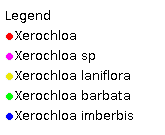Xerochloa Prodr. 196 (1810).
Derivation:. From Greek xeros (dry) and chloe (grass), referring to the dry nature of the grass.
Key references (keys and floras):. G.Bentham, Flora Australiensis 7: 501–502 (1878); C.A.Gardner, Flora of Western Australia 1 (Gramineae) 290–297 (1952); J.C.Tothill and J.B.Hacker, Grasses of Southern Queensland 436–437 (1983); R.D.Webster, Australian Paniceae 261–264 (1987); T.D.Macfarlane, Flora of the Kimberley Region 1244–1246 (1992); B.K.Simon, Key to Australian Grasses 176 (1993); D.Sharp and B.K.Simon, AusGrass (2002).
W.D.Clayton & S.A.Renvoize, Genera Graminum (1986), genus (543).
Native. 4 species, from Thailand, Java, Australia. 3 species in Australia, WA, NT, and Qld.
Habit. Annual (rarely) or perennial, tufted (often rush-like) or decumbent. Culms woody and persistent, or herbaceous. Leaf blades narrow. Ligule a fringed membrane (very reduced).
Inflorescence. Inflorescence paniculate (of globose, spathaceous units, fascicled and interspersed with prophylls, the fascicled units solitary and terminating the culm, or arranged in a leafy panicle), a spatheathe panicle, spatheate, terminal branches contracted into tight heads, a compound pseudo-inflorescence. Spikelet-bearing axes much reduced (to very short spikes, with tough rachides), clustered (with groups of 3–5 in a spathe), falling entire or disarticulating at joints (the ultimate units breaking up, or falling entire).
Spikelets. Spikelets all partially embedded in rachis or not all embedded, laterally compressed to dorsally compressed, 2 flowered, with 1 fertile floret, solitary, sessile. Fertile spikelets with lower incomplete floret(s), oblong or elliptic or lanceolate or ovate or obovate, abaxial (with lower glume on side away from rachis), falling with glumes (with the spikelet bearing axes falling, and a second zone of disarticulation beneath the glumes).
Glumes. Glumes one per spikelet or two, unequal, shorter than adjacent lemmas, hairy or hairless, awnless, non-keeled. Lower glume 0–1 nerved. Upper glume 2–5 nerved.
Florets. Lower incomplete floret(s) male, or sterile. Lemmas awnless, 3–9 nerved, more or less equalling fertile lemmas to exceeding fertile lemmas, similar in texture to fertile lemmas (membranous to cartilaginous, with a hyaline area at the base). Fertile florets 1. Lemmas acuminate, decidedly firmer than glumes (membranous to cartilaginous), smooth to rugose (or muricate), becoming indurated to not becoming indurated, white in fruit or yellow in fruit or brown in fruit, entire at apex, muticous, without a germination flap, 2 nerved, glabrous. Palea textured like lemma, 2 nerved. Stamens 3 or 0 (or staminodal?). Grain compressed dorsiventrally. Hilum short. Embryo large.
Kranz Anatomy. C4.
Habitat. Xerophytic (extreme). Dry stream beds and clay flats. Species of open habitats.
Classification. Panicoideae; Paniceae.
Notes. Diagnostic characteristics of the genus are the derived features of the inflorescence, which is solitary and clustered in a spatheate raceme. This is intermediate between the typical Panicum form and the Zygochloa form. Xerochloa is morphologically most similar to Zygochloa and Spinifex (Webster 1987). However it is not dioecious, whereas Zygochloa and Spinifex both are (B.K.Simon).
Types Species. X. imberbis R.Br.
Biogeographic Element. Clifford & Simon 1981, Simon & Jacobs 1990: Indo-Malayan.


